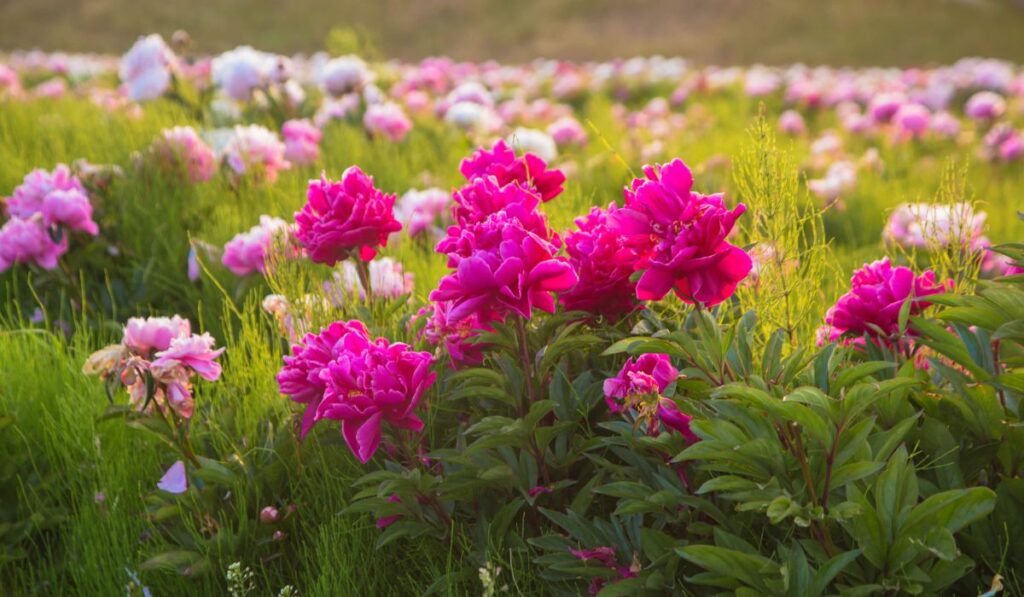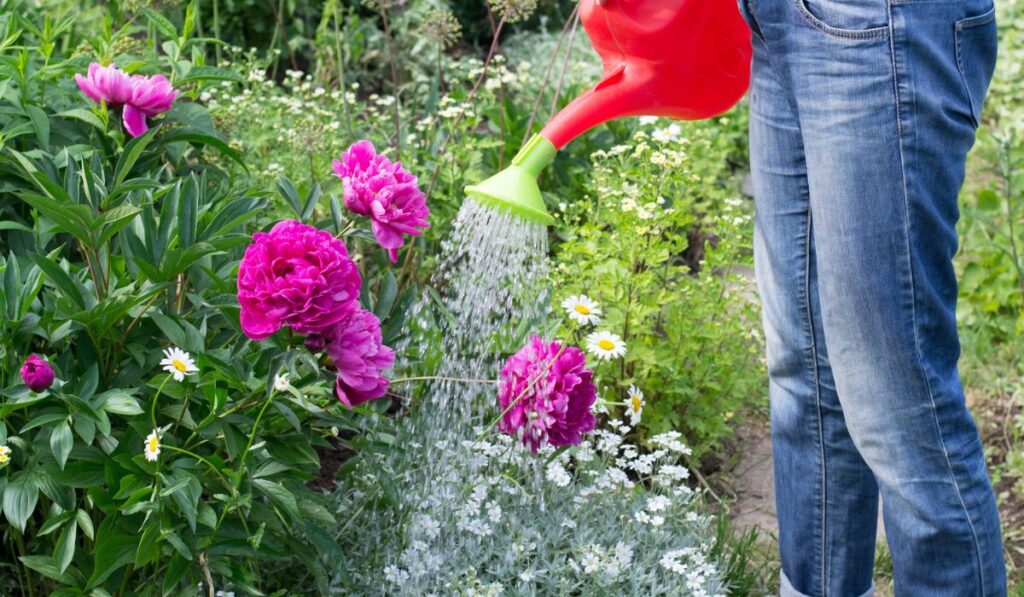Peonies are one of the most popular and beloved perennials. This is hardly surprising considering their stunning beauty, fragrant flowers, lush green foliage, longevity, and trouble-free nature. They also thrive almost anywhere they’re planted. So, when and how can you plant your own peonies?
Fall is the best time to plant bare root herbaceous, intersectional, and tree peonies. Dig holes 3-4 feet apart in well-drained soil. Add some organic materials to the holes. Next, put the peony roots just two inches below the soil surface and backfill the hole. Finally, water the plants well.
Peonies that are properly planted and cared for are bound to brighten up any garden, and they can live up to 100 years! Let’s get into the details, so that you can learn everything you need to know about peonies, from planting them to caring for them as they grow.
When’s the Best Time to Plant Peonies?

You can plant potted herbaceous and intersectional peonies at any time of the year, but the best times are in late April, May, or September.
Fall is probably the most ideal time to plant bare root herbaceous and intersectional peonies. Likewise, potted or bare root tree peonies also do well if you plant them during fall.
Different Types of Peonies
There are three types of peonies, each with several varieties. They include:
Herbaceous Peonies
These are the most popular types of peonies. They grow masses of blooms each spring and then die back to the ground in late autumn. New stems sprout in early spring in preparation for the next late spring bloom.
Herbaceous peonies are generally low-maintenance. While some peonies can hold up flowers on their own, other herbaceous peonies may need extra support in certain climates or situations.
Their stems only last one growing season, unlike tree peony stems, which are permanent. You can divide the roots of herbaceous peonies in late fall or early spring to rejuvenate them and create new propagation plants.
Varieties include Sarah Bernhardt, Coral Charm, Bowl of Beauty, Karl Rosenfield, and Duchesse de Nemours.
Tree Peonies
These peonies form a permanent woody stem. While the more popular herbaceous peonies have stems that die back to the ground every autumn, the tree peonies are more like hardy shrubs. Their woody stalks stay standing all through winter and go on to flower again the following season.
Most people know peonies for their huge, sweet-scented flowers and delicate foliage. Their woody stalks allow them to produce huge flowers that don’t need to be propped up. Their flowers also tend to last much longer than those of herbaceous peonies.
Established tree peonies grow larger than established herbaceous peonies and produce more flowers on a single plant. Their major weakness is that they are much less tolerant of harsh environmental conditions when compared to their herbaceous counterparts.
Generally, tree peonies require more annual maintenance than herbaceous peonies and usually benefit from expert pruning.
Tree peony varieties include Renkaku, High Noon, Shima-Nishiki, Shimadaijin, and Koukamon.
Intersectional Peonies
Also called Itoh peonies, the intersectional peonies are modern peony types that are typically a crossbreed between herbaceous and tree peonies. They have big, scented flowers and fine foliage. Aside from that, they can tolerate cold environmental conditions and maintain a compact growth habit.
Intersectional peonies bloom a few weeks later than herbaceous peonies. Adding them to your garden could help prolong peony season into early summer.
Varieties include Cora Louise, Julia Rose, Hillary, Bartzella, and Garden Treasure.
How to Plant Peonies
Planting peonies is a fun and relatively straightforward activity. Here’s how to do it:
- Purchase the peonies, usually sold as bare-root tubers with three to five eyes (buds).
- Space them 3-4 feet apart to allow for good air circulation between the plants. Stagnant, humid air encourages diseases to develop.
- Dig a huge hole, about two feet deep and two feet across, in well-drained soil in a spot that gets enough sunlight.
- Add some organic materials to the planting hole to give the soil extra nutrients. If the soil is heavy or sandy, you can enrich it with compost. You can incorporate a cup of bone meal (on Amazon) into the soil as well.
- Place the roots just two inches below the soil surface so that the eyes face upward on top of the pile of soil on the hole. If you live in southern states, go for early-blooming varieties. Plant them about an inch deep and provide a bit of shade.
- Backfill the hole, ensuring that the soil doesn’t settle and bury the root deeper than the recommended two inches. If you’re planting container-grown peonies, cover them no deeper than when they grew in the pot.
- Finally, water the plants generously.
How to Care for Peonies
Despite the myths surrounding them, peonies are easy plants to grow and care for. Here’s how to care for them properly:
- Provide the peonies shelter from strong winds because the large blooms make their tops heavy. However, don’t plant them too close to trees or shrubs, as peonies don’t like competing for food, moisture, and light.
- Ensure they get good air circulation to avoid fungal diseases like botrytis and powdery mildew.
- Sometimes the peonies’ stems aren’t strong enough to support their humongous blossoms, making them structurally weak. You could introduce three-legged metal peony rings (on Amazon) or wire tomato cages to support the plants as they grow.
- Deadhead the peonies as soon as they finish flowering. The petals will turn brown and unsightly. Cut the stem just below the old bloom, leaving only the foliage.
- When the temperatures are extremely low (especially during the first winter after planting the peonies), you can mulch them loosely with shredded bark or pine needles to avoid smothering them with mulch. Remove the mulch in the spring.
Like kids, young peonies take time to develop. They typically need a few years to establish themselves, bloom, and grow. Once they mature, they don’t need too much attention. Unlike most perennials, you don’t need to dig and divide peonies every few years.
Tips on Growing Peonies

Here are a few tips that could be helpful when growing peonies:
- Be careful with how deep you plant the peonies. Planting them too deep prevents them from flowering. You need to plant herbaceous peonies with budding stems no more than 2cm beneath the soil surface.
- Peonies need a lot of water — but not so much that they get waterlogged. So, plant them in soil that drains well; clay should do it as long as you don’t allow it to stay wet for too long.
- Grow peonies in deep, fertile, humus-rich soil with a neutral pH.
- Peonies thrive in full sun and will flower best in that position, but they can still tolerate light shade.
- If you’ve noticed ants running around your precious peonies, it would be best not to get rid of them. Ants don’t pose any danger to the flowers. Instead, as the bud swells, they appear and feed on the sugary substance it expels and even help the bud open properly. The ants will just disappear on their own as soon as the buds start to open.
- Be patient with the peonies — they don’t flower in their first year of planting. It could take 2-3 years for the plants to bloom. Once mature, peonies in the sun can produce as many as 50 flowers yearly for their entire lifetime.
